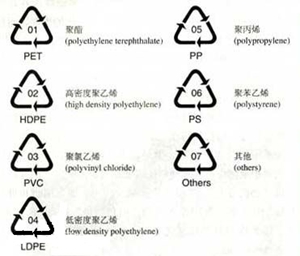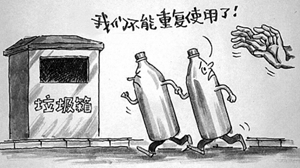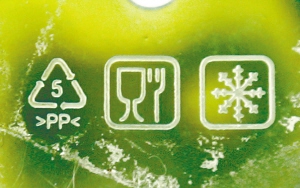Let Us Cognize the Plastic Recycling Symbols
Have you ever noticed the triangular symbols printed on the plastic bottles, bags or other containers? They are plastic recycling symbols, formulated by the related institution of American plastic industry.
This set of symbols are designed for common people to easily cognize various kinds of plastics and a correct way to use and recycle them. That is to say, the plastic recycling symbols service as the identification of the plastic products. By observing carefully, we can see the number in the center of the triangle, from one to seven, standing for the different plastic materials. Plastic products with different numbers in the triangle have their own physical and chemical properties and matters needing attention, so it’s necessary to have a basic cognition about the symbols.

Plastic Recycling Signs
NO.1 PET
The commonly seen plastic bottles for water and Sodas are the products made from PET, which would be out of shape and release toxic at the temperature of 70℃. After being used for over 10 months, PET bottles would give out a carcinogen named DEHP, so they’d better be recycled rather than used continually after several months’ usage. In addition, they should not be exposed to the sunlight when put in a car. Liquors and oils are the wrong liquids for PET bottles.
NO.2 HDPE
HDPE can be used in the production of containers for residues, shampoo, body wash, edible oil, pesticides and so on. It should not be reused as cups, or containers for other things, because it cannot be cleaned thoroughly.

Non Reusable Plastic Bottles
NO.3 PVC
PVC are usually used to produce raincoats, water pipes, bags, building materials, plastic film, plastic boxes and so on. PVC has a good plasticity and is very cheap, so it is widely used. However, it would release harmful substance at the temperature above 81℃, which make it unsuitable for food package or drink bottles. The residues on PVC is hard to clean so there is no need to reuse it.
NO.4 LDPE
Preservative film, plastic film and plastic bags are usually made from LDPE. The harmful substance produced by hyperthermia would be taken into the human bodies with the food, and cause diseases, such as mammary cancer, congenital defect of new born babies. That is to say, when warming food in a microwave oven, don’t forget to tear off the Preservative film.
NO.5 PP
PP is usually the material used to make buckets, garbage can, bamboo crate, basket, food container for microwave oven, such as soybean milk bottles, Yogurt bottles, fruit drink bottles, lunch boxes and so on. It is important to note that some lunch boxes for microwave oven consist of PP bottom and PE top, which belongs to the NO. 4 material and cannot stand the high temperature, so the top should be taken off from the bottom when being warmed in the microwave oven.

NO.5 PP Plastic Recycling Sign
NO.6 PS
As PS has a weak water absorption, so it is mostly used for producing building materials, toys, stationery, wheels, and foam fast-food boxes. PS should not be put into the microwave oven, otherwise it would bring chemical substances at the high temperature. What’s more, PS would produce carcinogenic substance by contacting with acid and alkali. Tips for daily life, don’t pack the hot food with foam fast-food boxes, and don’t warm the instant noodles directly with the foam bowls.
NO.7 Others
Other materials like PC, is frequently-used for making water bottles, baby's bottle and other PC bottles. However, high temperature would make it easy to release Bisphenol A, which is toxic, so it should not be heated and exposed to the sunlight directly. And the material PA, also named nylon, is used for fibre textile and inside fabrication of house appliances.
All above are the seven plastic recycling signs. Only when we have at least a basic cognition of them, can we use them safely and healthily, and also deal with the plastic wastes appropriately, most of which are recyclable. Take EPS/Expanded Polystyrene for an example, which is a derivation of PS. EPS waste can be recycled and compressed into EPS blocks by machines, about which our company supplies a series of compactors, named GREENMAX, and then made into other new products. Just like EPS Recycling, other waste recycling business also can transfer the trash into new valuable things.
